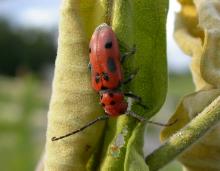Land Invertebrates
Media

Species Types
Scientific Name
Bombus spp.
Description
Bumblebees are like huge honeybees: They are yellow and black, collect pollen and nectar, live in colonies, and make honey. They are capable of stinging, if molested or if their nest is endangered, but you need not fear them; they are not aggressive.
Media

Species Types
Scientific Name
Nearly 90 species in North America north of Mexico
Description
Leaf-footed bugs are a large family of true bugs that are named for the flattened, leaflike extensions that many have on their hind legs. They fly well, and many smell bad when handled. Squash bugs are a famous member of this group.
Media

Species Types
Scientific Name
Nicrophorus, Necrophila, Necrodes, and others
Description
Beetles in the family Silphidae are called carrion beetles, burying beetles, and sexton beetles. They are usually black and often have red, orange, or yellow markings. Members of this group eat dead animals or scavenge dung or decaying plant material.
Media

Species Types
Scientific Name
About 1,000 species in North America north of Mexico
Description
Longhorned beetles are elongated and cylindrical, with antennae that are at least half the length of the body — sometimes much longer. The larvae are grubs that bore in wood or other plants. Some are serious pests.
Media
Species Types
Scientific Name
Sphecius speciosus
Description
The eastern cicada-killer wasp might be the scariest-looking wasp in our state. But it is not aggressive to people and is virtually harmless, unless handled roughly. Like other ground-nesting wasps, nests can be recognized by the mound of earth excavated by the female.
Media

Species Types
Scientific Name
About 300 species in North America north of Mexico
Description
People notice spider wasps when they notice a female lugging a captured spider to its doom. In most cases, she will drag the spider into a burrow, lay an egg on the spider, and then hunt for more spiders!
Media

Species Types
Scientific Name
Three genera: Sceliphron, Trypoxylon, and Chalybion
Description
Mud daubers are among the most familiar solitary wasps. They belong to a number of related groups, but we call them all "mud daubers" because they all build their nests out of mud. One way to tell the different mud daubers apart is by the distinctive architecture they use.
Media

Species Types
Scientific Name
Nearly 500 species in North America north of Mexico
Description
Velvet ants are not true ants. True ants are social insects, while velvet ants are a group of solitary wasps. Female velvet ants are wingless throughout their lives; males are winged.
Media

Species Types
Scientific Name
Scutigera coleoptrata
Description
Exceedingly fast, with zillions of wiggly legs! House centipedes seem that way. We usually see them in houses, where they prey on all the other insects and spiders you don't want around.
Media

Species Types
Scientific Name
Tabanus, Chrysops, and related genera
Description
Meet the horse fly: Stealthily, one will land on your back, slice your skin, and lap your blood. By the time it starts to hurt and you swat at it, the painful, itchy welt is rising.
See Also



Media

Species Types
Scientific Name
Cisseps fulvicollis
Description
The yellow-collared scape moth is more often “orange-collared.” And whether you think it looks more like a firefly or a wasp, it’s still a moth!
Media

Species Types
Scientific Name
Nearly 150 species in North America north of Mexico
Description
Slim, delicate plume moths are instantly recognizable by their T-shaped silhouette, long legs, and muted shades of tan and brown. It can be hard to separate the various species.
Media

Species Types
Scientific Name
Pyrrharctia isabella
Description
Not many people know the adult Isabella tiger moth when they see one, but we’re all acquainted with its caterpillar, the woolly worm, or woolly bear.
About Land Invertebrates in Missouri
Invertebrates are animals without backbones, including earthworms, slugs, snails, and arthropods. Arthropods—invertebrates with “jointed legs” — are a group of invertebrates that includes crayfish, shrimp, millipedes, centipedes, mites, spiders, and insects. There may be as many as 10 million species of insects alive on earth today, and they probably constitute more than 90 percent all animal species.





















